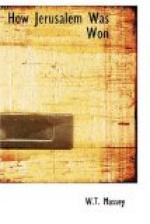While the 54th were coming up to take over from the 52nd, plans were prepared for the further advance on Jerusalem. The Commander-in-Chief was deeply anxious that there should be no fighting of any description near the Holy Places, and he gave the Turks a chance of being chivalrous and of accepting the inevitable. We had got so far that the ancient routes taken by armies which had captured Jerusalem were just before us. The Turkish forces were disorganised by heavy and repeated defeats, the men demoralised and not in good condition, and there was no hope for them that they could receive sufficient reinforcements to enable them to stave off the ultimate capture of Bethlehem and Jerusalem, though as events proved they could still put up a stout defence. We know from papers taken from the enemy that the Turks believed General Allenby intended to go right up the plain to get to the defile leading to Messudieh and Nablus and thus threaten the Hedjaz railway, in which case the position of the enemy in the Holy City would be hopeless, and the Turks formed an assault group of three infantry divisions in the neighbourhood of Tul Keram to prevent this, and continued to hold on to Jerusalem. General Allenby proposed to strike through the hills to the north-east to try to get across the Jerusalem-Nablus road about Bireh (the ancient Beeroth), and in this operation success would have enabled him to cut off the enemy forces in and about the Holy City, when their only line of retreat would have been through Jericho and the east of the Jordan. The Turks decided to oppose this plan and to make us fight for Jerusalem. That was disappointing, but in the end it could not have suited us better, for it showed to our own people and to the world how after the Turks had declined an opportunity of showing a desire to preserve the Holy Places from attack—an opportunity prompted by our strength, not by any fear that victory could not be won—General Allenby was still able to achieve his great objective without a drop of blood being spilled near any of the Holy Sites, and without so much as a stray rifle bullet searing any of their walls. That indeed was the triumph of military practice, and when Jerusalem fell for the twenty-third time, and thus for the first time passed into the hands of British soldiers, the whole force felt that the sacrifices which had been made on the gaunt forbidding hills to the north-west were worth the price, and that the graves of Englishman, Scot and Colonial, of Gurkha, Punjabi, and Sikh, were monuments to the honour of British arms. The scheme was that the 75th Division would advance along the main Jerusalem road, which cuts into the hills about three miles east of Latron, and occupy Kuryet el Enab, and that the Lowland Division should go through Ludd, strike eastwards and advance to Beit Likia to turn from the north the hills through which the road passes, the Yeomanry Mounted Division on the left flank of the 52nd Division to press on to Bireh, on the Nablus




